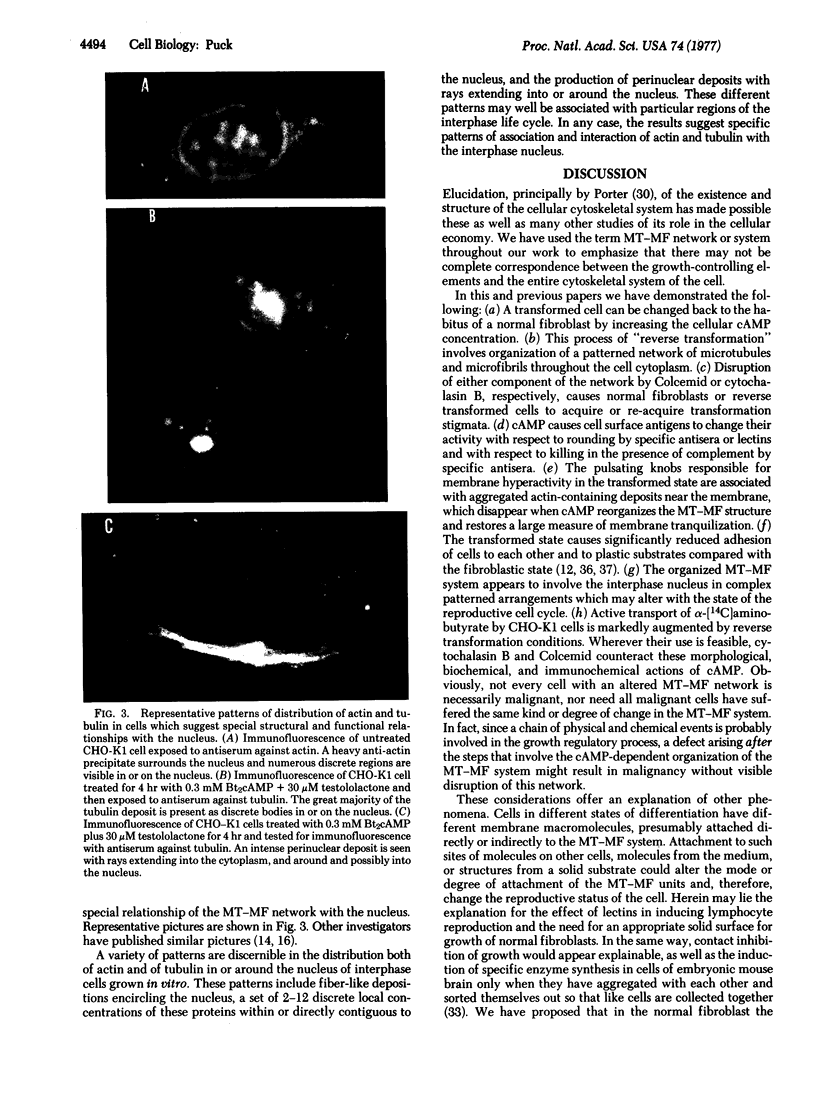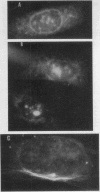Abstract
Additional evidence is presented for the previously proposed existence in normal fibroblasts of a cyclic AMP-dependent network of microtubules and microfilaments, which is connected with cell membrane elements on one end and with nuclear structures on the other and whose disorganization leads to malignant transformation. In the presence of cyclic AMP derivatives sufficient to promote integrity of this network, cell growth limitation in suspension, increased transport of alpha-[14C]aminobutyrate, and the relatively tranquilized membrane of the normal fibroblast are also achieved. A pattern of distribution of actin and tubulin has been demonstrated showing aggregated actin deposits which are presumably responsible for the oscillatory knob activity of cells with the transformed habitus. Specific orientations of microtubular and filamentous elements with respect to the nucleus can be demonstrated. The hypothesis that the microtubular-microfilamentous structure conveys growth-regulatory information from the cell membrane to the nucleus and that its disorganization can lead to malignancy has been extended to explain various cellular manifestations.
Full text
PDF




Images in this article
Selected References
These references are in PubMed. This may not be the complete list of references from this article.
- Brinkley B. R., Fuller E. M., Highfield D. P. Cytoplasmic microtubules in normal and transformed cells in culture: analysis by tubulin antibody immunofluorescence. Proc Natl Acad Sci U S A. 1975 Dec;72(12):4981–4985. doi: 10.1073/pnas.72.12.4981. [DOI] [PMC free article] [PubMed] [Google Scholar]
- Buckley I. K., Porter K. R. Cytoplasmic fibrils in living cultured cells. A light and electron microscope study. Protoplasma. 1967;64(4):349–380. doi: 10.1007/BF01666538. [DOI] [PubMed] [Google Scholar]
- Cox D. M., Puck T. T. Chromosomal nondisjunction: the action of colcemid on Chinese hamster cells in vitro. Cytogenetics. 1969;8(2):158–169. doi: 10.1159/000130032. [DOI] [PubMed] [Google Scholar]
- Edelman G. M., Yahara I., Wang J. L. Receptor mobility and receptor-cytoplasmic interactions in lymphocytes. Proc Natl Acad Sci U S A. 1973 May;70(5):1442–1446. doi: 10.1073/pnas.70.5.1442. [DOI] [PMC free article] [PubMed] [Google Scholar]
- Goldman R. D., Lazarides E., Pollack R., Weber K. The distribution of actin in non-muscle cells. The use of actin antibody in the localization of actin within the microfilament bundles of mouse 3T3 cells. Exp Cell Res. 1975 Feb;90(2):333–344. doi: 10.1016/0014-4827(75)90323-7. [DOI] [PubMed] [Google Scholar]
- Hsie A. W., Jones C., Puck T. T. Further changes in differentiation state accompanying the conversion of Chinese hamster cells of fibroblastic form by dibutyryl adenosine cyclic 3':5'-monophosphate and hormones. Proc Natl Acad Sci U S A. 1971 Jul;68(7):1648–1652. doi: 10.1073/pnas.68.7.1648. [DOI] [PMC free article] [PubMed] [Google Scholar]
- Hsie A. W., Puck T. T. Morphological transformation of Chinese hamster cells by dibutyryl adenosine cyclic 3':5'-monophosphate and testosterone. Proc Natl Acad Sci U S A. 1971 Feb;68(2):358–361. doi: 10.1073/pnas.68.2.358. [DOI] [PMC free article] [PubMed] [Google Scholar]
- Johnson G. S., Friedman R. M., Pastan I. Restoration of several morphological characteristics of normal fibroblasts in sarcoma cells treated with adenosine-3':5'-cyclic monphosphate and its derivatives. Proc Natl Acad Sci U S A. 1971 Feb;68(2):425–429. doi: 10.1073/pnas.68.2.425. [DOI] [PMC free article] [PubMed] [Google Scholar]
- Lazarides E., Weber K. Actin antibody: the specific visualization of actin filaments in non-muscle cells. Proc Natl Acad Sci U S A. 1974 Jun;71(6):2268–2272. doi: 10.1073/pnas.71.6.2268. [DOI] [PMC free article] [PubMed] [Google Scholar]
- MACPHERSON I., MONTAGNIER L. AGAR SUSPENSION CULTURE FOR THE SELECTIVE ASSAY OF CELLS TRANSFORMED BY POLYOMA VIRUS. Virology. 1964 Jun;23:291–294. doi: 10.1016/0042-6822(64)90301-0. [DOI] [PubMed] [Google Scholar]
- Ossowski L., Quigley J. P., Reich E. Fibrinolysis associated with oncogenic transformation. Morphological correlates. J Biol Chem. 1974 Jul 10;249(13):4312–4320. [PubMed] [Google Scholar]
- PUCK T. T., CIECIURA S. J., FISHER H. W. Clonal growth in vitro of human cells with fibroblastic morphology; comparison of growth and genetic characteristics of single epithelioid and fibroblast-like cells from a variety of human organs. J Exp Med. 1957 Jul 1;106(1):145–158. doi: 10.1084/jem.106.1.145. [DOI] [PMC free article] [PubMed] [Google Scholar]
- Patterson D., Waldren C. A. The effect of inhibitors of RNA and protein synthesis on dibutyryl cyclic AMP mediated morphological transformations of Chinese hamster ovary cells in vitro. Biochem Biophys Res Commun. 1973 Jan 23;50(2):566–573. doi: 10.1016/0006-291x(73)90877-2. [DOI] [PubMed] [Google Scholar]
- Pollack R., Osborn M., Weber K. Patterns of organization of actin and myosin in normal and transformed cultured cells. Proc Natl Acad Sci U S A. 1975 Mar;72(3):994–998. doi: 10.1073/pnas.72.3.994. [DOI] [PMC free article] [PubMed] [Google Scholar]
- Porter K. R., Puck T. T., Hsie A. W., Kelley D. An electron microscopy study of the effects on dibutyryl cyclic AMP on Chinese hamster ovary cells. Cell. 1974 Jul;2(3):145–162. doi: 10.1016/0092-8674(74)90089-0. [DOI] [PubMed] [Google Scholar]
- Puck T. T., Waldren C. A., Hsie A. W. Membrane dynamics in the action of dibutyryl adenosine 3':5'-cyclic monophosphate and testosterone on mammalian cells. Proc Natl Acad Sci U S A. 1972 Jul;69(7):1943–1947. doi: 10.1073/pnas.69.7.1943. [DOI] [PMC free article] [PubMed] [Google Scholar]
- Seeds N. W., Vatter A. E. Synaptogenesis in reaggregating brain cell culture. Proc Natl Acad Sci U S A. 1971 Dec;68(12):3219–3222. doi: 10.1073/pnas.68.12.3219. [DOI] [PMC free article] [PubMed] [Google Scholar]
- Singer S. J. Molecular biology of cellular membranes with applications to immunology. Adv Immunol. 1974;19(0):1–66. doi: 10.1016/s0065-2776(08)60251-5. [DOI] [PubMed] [Google Scholar]
- Storrie B. Antagonism by dibutyryl adenosine cyclic 3',5'-monophosphate and testololactone of concanavalin A capping. J Cell Biol. 1975 Aug;66(2):392–403. doi: 10.1083/jcb.66.2.392. [DOI] [PMC free article] [PubMed] [Google Scholar]
- TJIO J. H., PUCK T. T. Genetics of somatic mammalian cells. II. Chromosomal constitution of cells in tissue culture. J Exp Med. 1958 Aug 1;108(2):259–268. doi: 10.1084/jem.108.2.259. [DOI] [PMC free article] [PubMed] [Google Scholar]
- Veomett G., Prescott D. M., Shay J., Porter K. R. Reconstruction of mammalian cells from nuclear and cytoplasmic components separated by treatment with cytochalasin B. Proc Natl Acad Sci U S A. 1974 May;71(5):1999–2002. doi: 10.1073/pnas.71.5.1999. [DOI] [PMC free article] [PubMed] [Google Scholar]
- Wang J. L., McClain D. A., Edelman G. M. Modulation of lymphocyte mitogenesis. Proc Natl Acad Sci U S A. 1975 May;72(5):1917–1921. doi: 10.1073/pnas.72.5.1917. [DOI] [PMC free article] [PubMed] [Google Scholar]
- Willingham M. C., Carchman R. A., Pastan I. H. A mutant of 3T3 cells with cyclic AMP metabolism sensitive to temperature change. Proc Natl Acad Sci U S A. 1973 Oct;70(10):2906–2910. doi: 10.1073/pnas.70.10.2906. [DOI] [PMC free article] [PubMed] [Google Scholar]
- Willingham M. C. Cyclic AMP and cell behavior in cultured cells. Int Rev Cytol. 1976;44:319–363. doi: 10.1016/s0074-7696(08)61652-6. [DOI] [PubMed] [Google Scholar]
- Willingham M. C., Pastan I. Cyclic amp and cell morphology in cultured fibroblasts. Effects on cell shape, microfilament and microtubule distribution, and orientation to substratum. J Cell Biol. 1975 Oct;67(1):146–159. doi: 10.1083/jcb.67.1.146. [DOI] [PMC free article] [PubMed] [Google Scholar]




